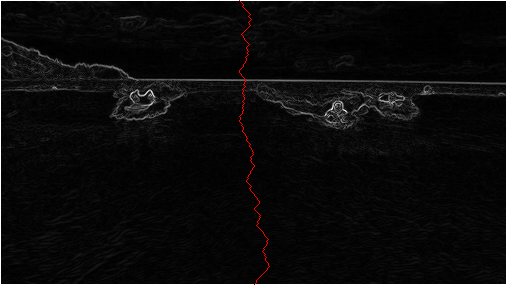 Seam Carving
Seam Carving
Although the underlying algorithm is simple and elegant, it was not discovered until 2007. Now, it is now a core feature in Adobe Photoshop and other computer graphics applications.


In this assignment, you will create a data type that resizes a W-by-H image using the seam-carving technique.
Finding and removing a seam involves three parts and a tiny bit of notation:
algs4.jar.
Warning: this is the opposite of the standard mathematical notation used in linear algebra
where (i, j) refers to row i and column j and with Cartesian
coordinates where (0, 0) is at the lower left corner.
| (0, 0) | (1, 0) | (2, 0) |
| (0, 1) | (1, 1) | (2, 1) |
| (0, 2) | (1, 2) | (2, 2) |
| (0, 3) | (1, 3) | (2, 3) |
We also assume that the color of a pixel is represented in RGB space, using three integers between 0 and 255. This is consistent with the java.awt.Color data type.

The energy is high (white) for pixels in the image where there is a rapid color gradient (such as the boundary between the sea and sky and the boundary between the surfing Josh Hug on the left and the ocean behind him). The seam-carving technique avoids removing such high-energy pixels.

The SeamCarver API. Your task is to implement the following mutable data type:
public class SeamCarver {
// create a seam carver object based on the given picture
public SeamCarver(Picture picture)
// current picture
public Picture picture()
// width of current picture
public int width()
// height of current picture
public int height()
// energy of pixel at column x and row y
public double energy(int x, int y)
// sequence of indices for horizontal seam
public int[] findHorizontalSeam()
// sequence of indices for vertical seam
public int[] findVerticalSeam()
// remove horizontal seam from current picture
public void removeHorizontalSeam(int[] seam)
// remove vertical seam from current picture
public void removeVerticalSeam(int[] seam)
// unit testing (optional)
public static void main(String[] args)
}
Corner cases.
Your code should throw an IllegalArgumentException when a constructor or method is called with
an invalid argument, as documented below:
IllegalArgumentException if either x or y
is outside its prescribed range.
IllegalArgumentException if the constructor,
removeVerticalSeam(), or removeHorizontalSeam() is called with a null argument.
IllegalArgumentException if removeVerticalSeam() or
removeHorizontalSeam() is called with an array of the wrong length
or if the array is not a valid seam (i.e., either an entry is outside its prescribed range
or two adjacent entries differ by more than 1).
IllegalArgumentException if removeVerticalSeam()
is called when the width of the picture is less than or equal to 1 or if
removeHorizontalSeam() is called when the height of the picture
is less than or equal to 1.
Picture argument to the constructor.
As an example, consider the 3-by-4 image (supplied as 3x4.png) with RGB values—each component is an integer between 0 and 255—as shown in the table below:

The ten border pixels have energy 1000. Only the pixels (1, 1) and (1, 2) are nontrivial. We calculate the energy of pixel (1, 2) in detail:
Rx(1, 2) = 255 − 255 = 0,
Gx(1, 2) = 205 − 203 = 2,
Bx(1, 2) = 255 − 51 = 204,
yielding Δx2(1, 2) = 22 + 2042 = 41620.
Ry(1, 2) = 255 − 255 = 0,
Gy(1, 2) = 255 − 153 = 102,
By(1, 2) = 153 − 153 = 0,
yielding Δy2(1, 2) = 1022 = 10404.
Thus, the energy of pixel (1, 2) is \(\sqrt{41620 + 10404} = \sqrt{52024}\).
Similarly, the energy of pixel (1, 1) is \(\sqrt{204^2 + 103^2}= \sqrt{52225}\).
findVerticalSeam() method returns an array of length H
such that entry y is the column number of the pixel to
be removed from row y of the image.
For example, the dual-gradient energies of a 6-by-5 image
(supplied as 6x5.png).

The minimum energy vertical seam is highlighted in blue.
In this case, the method findVerticalSeam() returns the array { 3, 4, 3, 2, 2 }
because the pixels in a minimum energy vertical seam are
(3, 0),
(4, 1),
(3, 2),
(2, 3), and
(2, 4).
When there are multiple vertical seams with minimal total energy, your method can return
any such seam.
Finding a horizontal seam.
The behavior of findHorizontalSeam() is
analogous to that of findVerticalSeam() except that it returns
an array of length width such that entry x is the row number of
the pixel to be removed from column x of the image.
For the 6-by-5 image, the method findHorizontalSeam() returns the array { 2, 2, 1, 2, 1, 2 }
because the pixels in a minimum energy horizontal seam are
(0, 2),
(1, 2),
(2, 1),
(3, 2),
(4, 1), and
(5, 2).

Performance requirements.
The width(), height(), and energy() methods should take constant time in the worst case.
All other methods should run in time at most proportional to width × height in the worst case.
For faster performance, do not construct explicit DirectedEdge and
EdgeWeightedDigraph objects.
Analysis of running time (optional and not graded).
Web submission.
Submit a .zip file containing SeamCarver.java and any other supporting files
(excluding algs4.jar and SCUtility.java).
You may not call any library functions except those in
java.lang, java.util, java.awt.Color, and algs4.jar.